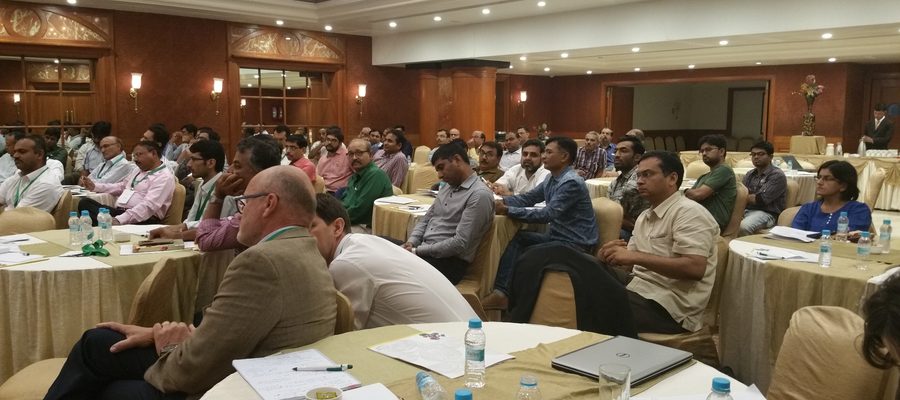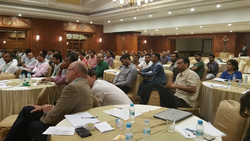Stakeholder Workshop in Rajkot Launches CapaCITIES

A workshop was recently organised in Rajkot city of Gujarat to launch the Capacity Building Project on Low Carbon and Climate Resilient City Development in India (CapaCITIES) Project. The project will be implemented in Rajkot, Udaipur, Siliguri and Coimbatore. Rajkot Municipal Corporation (RMC), jointly with the Swiss Development Cooperation (SDC) and the three other cities, has initiated the CapaCITIES project, being implemented by the Indian – Swiss Consortium ICLEI-Local Governments for Sustainability, South Asia (ICLEI South Asia), South Pole Group Ltd. and econcept Ltd., with the goal to achieve lower greenhouse gas emissions growth path for selected cities and to increase their resilience to climate change.
CapaCITIES shall mainstream climate change mitigation and adaptation into development policies at city level. The project will support city authorities in formulation and implementation of integrated action plans and measures across priority sectors, such as Greenhouse Gas reductions in the building sector, the transportation sector, the sewage and solid waste sector, and in the water sector. An important aspect of CapaCITIES is the sharing of experience with other cities in India and other emerging countries.
The project was launched by Mr Daniel Ziegerer, Director, SDC, at the workshop that was held on July 19, 2016, in presence of Mr Govindbhai Patel, Honourable Minister of State, Energy and Power, Government of Gujarat. The first workshop in the framework of CapaCITIES focused mainly on accelerating and promoting the green building design concept in Rajkot and targeted city representatives, the builders’ association, the architects’ association, association of civil consulting engineers and the Rajkot Chamber of Commerce.
The workshop offered a unique platform to discuss and highlight features of green building designs, financial implications of green building interventions, and led to a discussion on the potential for adopting green building concepts in Rajkot. Local perspectives and views of local stakeholders were put forth, thus leading to identification of quick-win opportunities for promoting close to net-zero buildings in Rajkot.
During the discussions, prime concerns and challenges for local level implementation were identified, indicating a larger role for regulation.
Honourable Minister Shri Govindbhai Patel, Honourable Mayor Shri Jaimanbhai Upadhyay, Honourable Deputy Mayor Smt Darshanaben Shah, Honourable Municipal Commissioner Shri Vijay Nehra, standing committee chairman Shri Pushkarbhai Patel, Mr Daniel Ziegerer, Director, SDC, and Mr Emani Kumar, Deputy Secretary General (ICLEI) and Executive Director, ICLEI South Asia participated in the inaugural session.
Alexander Luchinger, Co-Team Leader, CapaCITIES, Mr Shirish Sinha, Deputy Director, SDC, Ms Nadia Bohli, Senior Consultant, South Pole Group, Mr Reto Johannes Dettli, Partner, econcept AG were also present at the launch workshop. Dr. Sameer Maithel, Founder Director, Greentech Knowledge Solutions, provided technical inputs to the sessions.
Welcoming the CapaCITIES team, Mr Vijay Nehra expressed his gratitude for selecting Rajkot as one of the four cities selected for the project. He added that projects like this will help Rajkot in mainstreaming climate change mitigation and adaptation and that the city was proud to have developed a low carbon action plan and was gearing up to be a smart city.
Mr. Daniel Ziegerer, Director, SDC, explained that the Corporation’s Global Programme on Climate Change (GPCC) supports innovative climate change and mitigation projects in selected partner countries and facilitates the generation and dissemination of knowledge, along with engagement in climate change policy processes. In India, SDC’s goal is to contribute to a climate compatible development over the long run. Though Rajkot has already done a lot to achieve sustainable development for the city, a dialogue on city’s framework for policy development and implementation is much needed. Through this project, there is also the opportunity for international knowledge transfer and its adoption in local context.
Mr Alexander Luchinger also presented the project design and deliverables of CapaCITIES. Among other partners, South Pole Group is presently involved in climate policy advisory, emission reduction project implementation, project management, project finance and climate finance advices and ICLEI Local Governments for Sustainability South Asia is involved in climate mitigation and adaptation projects through its association with over 50 cities. Another implementation partner (econcept) is involved in providing support to cities participating in the European Energy Award programme in Switzerland and in Europe, focusing on economic aspects of energy efficiency, sustainable buildings, energy supply and climate change adaptation projects.
Dr Jaiman Upadhyay, Honourable Mayor, RMC, said that after successful implementation of the Urban LEDS project and after being declared as the National Earth Hour Capital in the Earth Hour city challenge of the WWF, Rajkot is furthering the resilient development agenda, by implementing the SDC’s CapaCITIES project. The RMC has a target to complete more than 15,000 affordable housing units till year 2016-17, where integration of green building designs is much needed. The consultations at the green building workshop were more relevant as under the Government of India’s Smart City Mission, 80 per cent of total buildings should be “green buildings”, in the area based development proposed in Rajkot’s Smart city plan.
In his welcome remarks, Mr Govindbhai Patel, Honourable Energy Minister, Gujarat, congratulated the political and administrative wing of Rajkot for their commitment to climate-oriented development and ensured support from the state government. Gujarat’s new solar policy allows a subsidy of Rs 20,000 from Central government and Rs 10,000 from the state government for installation of rooftop SPV system of 1kW capacity, and Rajkot should make good use of this policy, he said.
The opening session of the launch workshop was followed by two technical sessions. While the first session focused on green building technologies, the second session included deliberations over green building policies and regulations.
Technical Session 1: Green building Design – Technology
In the first session, moderated by Mr Daniel Ziegerer, the Indo-Swiss Building Energy Efficiency Project (BEEP) was presented by Mr Sameer Maithel. He discussed the importance of green and climate responsive designs, energy efficient appliances and energy conscious occupants in ensuring an Energy Performance Index (EPI) of 20 to 40kWh/m2/year in buildings, as against 80 to 100kWh/m2/year due to poor building designs. “A design approach that integrates architectural and engineering solutions at an early design stage is required for ensuring an energy-efficient design,” he added.
Ms Alpana Mitra, In-charge City Engineer, Housing Department, RMC, discussed the ongoing affordable housing projects and explained that RMC was doing its best to incorporate green building design by providing LED lights, using Autoclaved Aerated Concrete (AAC) blocks, and providing rain water harvesting pits in affordable housing schemes. The city has also identified 10 school buildings to be developed as green schools. Thereafter, Ms Soumya Chaturvedula, Program Coordinator, Energy and Climate, ICLEI South Asia, summarized the result and scope of Low Carbon projects implemented/being implemented in Rajkot, which include: Renewable Energy & Efficiency in Buildings & Cities: Assessing Potential for District Energy Systems (DES) in Indian Cities, a project by UNEP, pilot projects implemented in identified sectors, the Low Emission Development Strategies prepared for year 2019-20 under the Urban LEDS project and also Rajkot’s involvement in the Building Energy Accelerator Programme being supported by the World Resources Institute. RMC has already mainstreamed and scaled up pilot projects that were implemented under Urban LEDS project.
Key questions from stakeholders at the session were responded by the panelists. Below are the edited excerpts:
Is there any example of successful implementation in District Cooling System in India? Why are we implementing such a technology if it is not proven successful?
A prefeasibility study is underway in five cities, through which we have tried to identify potential areas in cities and understand whether effective implementation of such projects is possible in Indian cities or not, Ms Chaturvedula explained. District cooling systems have a larger application in mixed land use development, where a diversity of cooling loads is possible, she added.
Some of the technologies applied in green buildings are cost intensive. What should be done to successfully implement such technologies?
Agreeing to the same, Mr Maithel suggested that detailed technical analysis in terms of solar radiation, wind direction, building design and locally available technologies is required to ensure inclusion of passive architectural features at the design stage itself.
Since you have done a lot of monitoring of energy consumption in residential buildings, where was highest quantum of energy used in buildings; is it in lighting, air conditioning system or other equipment use?
Data from Delhi, a city that has temperatures comparable to Rajkot in summer, indicates that in in household units without air conditioning systems, 70 percent of energy is used for lighting and 30 percent for cooling purposes, Mr. Maithel explained. In household units with air conditioning systems, 50 percent of energy use is dedicated to cooling purposes and 20 percent to water heating requirements annually.
Considering water harvesting in the urban situation, could you share some information and views on how to conserve rainwater? If we talk about a mandatory bye-law for rain water harvesting and promote bore recharge through roof rain water, it may become dangerous to discharge water directly into the aquifer as contaminated roof rain water may pollute the aquifer.
Ms. Mitra indicated that the Town Planning Department of RMC is taking enough care to promote scientific systems for rainwater harvesting and such systems are installed by builders and are verified while issuing building completion certificates, she explained. Other experts on the panel indicated that some technical solutions and design change may be proposed to ensure that the rain water quality does not impact ground water quality adversely.
Ms Soumya Chaturvedula agreed that monitoring of rainwater after installation of system is not done. She added that water contamination from car wash, dry waste, oil contamination (if vacant land is used for parking), fecal contamination from certain areas needs to be addressed. “We should know what we are putting into the ground. The suggestion on monitoring quality of rainwater being diverted to recharge wells is well taken, and will be addressed through the project,” she assured.
Technical Session 2: Green building Design – Policy and Regulation
The second session, moderated by Mr Shirish Sinha, Deputy Director, SDC, focused on policy and regulation around green buildings.
Mr Sameer Maithel shared the Swiss experience in energy efficiency regulations, integrated design approach of commercial and public buildings, strategies and tools used for monitoring of energy savings. He also explained the integrated design charrette approach with examples of some case studies and how the charrette programme by BEEP (to provide technical support in the form of four-day design workshop for specific building design projects) helped to reduce Energy Performance Index (EPI) in building use. About 20 to 50 percent energy can be saved in buildings after adopting energy efficiency strategies, he added.
Below are the questions and responses from stakeholder discussions after the session:
The presentations seem to be generic. Is there a case study that is relevant to building typologies specific to Rajkot?
Since this is the beginning of the project, the presentations cannot be specific, clarified Mr Sameer Maithel. But he agreed that the specific project and specific solutions are needed. We can prepare framework in which we can look at specific projects from the perspective of energy needs, and such projects may be included in the design charette proposed earlier, he added. Mr Maithel also emphasised that the stakeholders should work together to develop a green building framework specific to Rajkot city.
Shouldn’t all the solutions that are proposed be evaluated prior to inclusion in a regulation, as each solution will have some cost to it that will affect the market price?
We have national and international experts and will consider inputs from experts from within the city under this project. Therefore, the solutions developed under this project will be evaluated in terms of technical and financial viability; these considerations are included in the design charrette project.
It will be very helpful to design for specific cases and prepare a generic framework for the city, added Mr Shirish Sinha. “Whatever is discussed will not have an impact if there is no demand, so solutions proposed should cater to the assessed demand in the city,” said Ms Soumya Chaturvedula. A consensus building dialogue approach will be followed to ensure relevance of solutions and policies proposed, she added.
Is there any benchmark for Rajkot, to which we can compare city’s GHG emission or carbon generation?
GHG inventory for Rajkot city has been prepared for 2012-13 under Urban Low Emission Development Strategy Project, which will be updated during this project. So, we will soon be in a position to tell you where the city stands in terms of carbon emissions, Mr Emani Kumar replied. “Also, we will be looking at resilient part and some quick win projects under this project and impact of each activity will be added in inventory,” he added.
“It is very important to benchmark not only at the national level but also internationally,” said Mr Daniel Ziegerer. Experience of European Energy Award (EEA) methodology will also be shared through this project as experts who designed and supported adoption of the European Energy Award (EEA) approach are in the project team.
To conclude the workshop, Mr Alexander Luchinger expressed his gratitude to all participants for their support and discussions on next steps of project. Our cooperation starts today and will continue for next few years, he said. “The very first step is to form a stakeholder committee and start collecting good ideas for identified sectors as we cannot look into all sectors,” added Mr Luchinger.
Mr Emani Kumar from ICLEI also expressed his gratitude to all participants for their active involvement in the workshop. “We want to engage all of you to make Rajkot a low carbon city. Knowledge management, capacity building through workshop and seminars, and bringing best practices from other partner cities and international cities are a major component of this project. We would require your support for successful implementation of this project,” he added.




